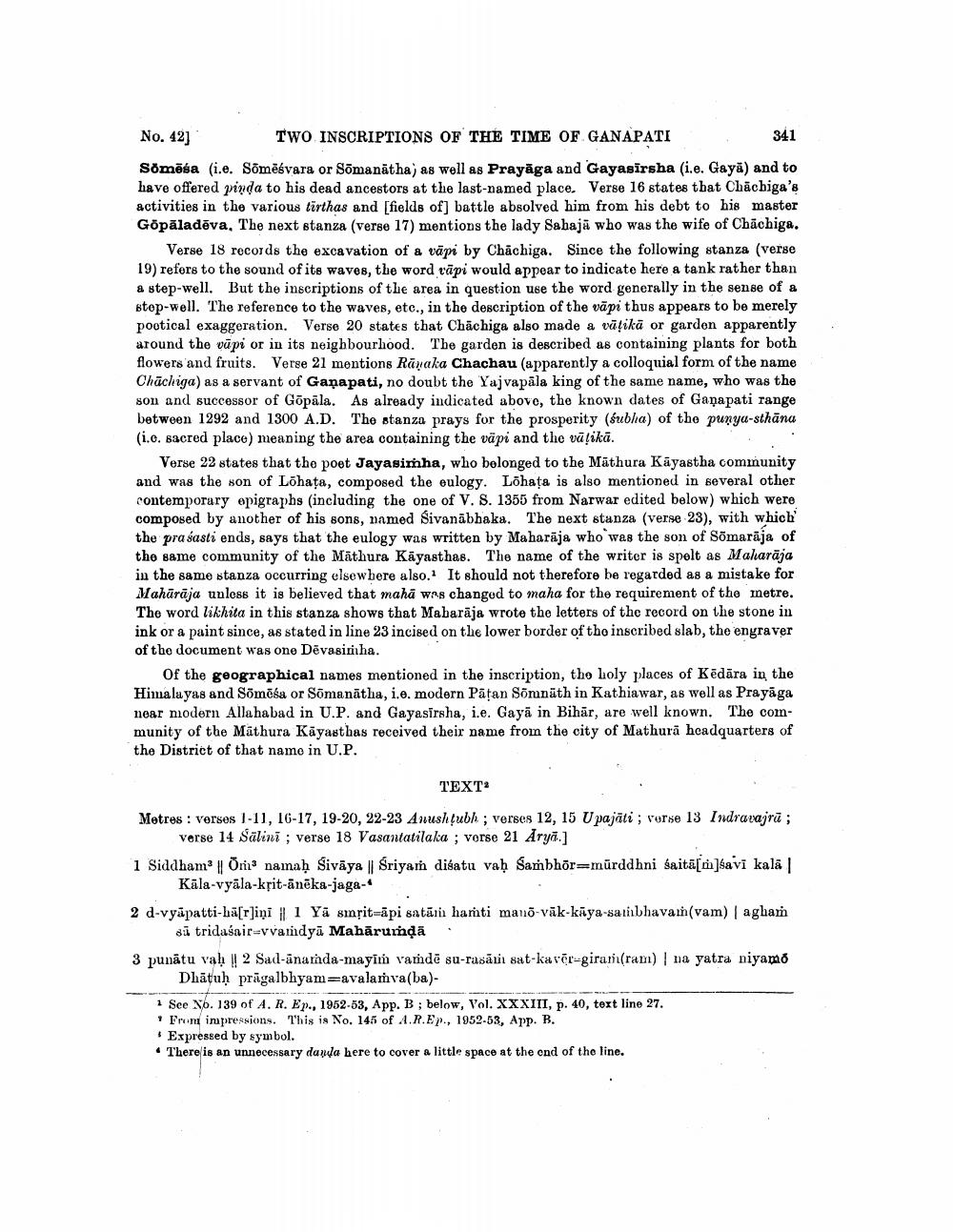________________
No. 42]
TWO INSCRIPTIONS OF THE TIME OF GANAPATI
341
Somēśa (i.e. Sõmēśvara or Sõmanātha, as well as Prayāga and Gayasīrsha (i.e. Gayā) and to have offered pinda to his dead ancestors at the last-named place. Verse 16 states that Chächiga's activities in the various tirthas and [fields of] battle absolved him from his debt to his master Gopāladēva, The next stanza (verse 17) mentions the lady Sabaja who was the wife of Chächiga.
Verse 18 records the excavation of a vāpi by Chächiga. Since the following stanza (verse 19) refers to the sound of its waves, the word rāpi would appear to indicate here a tank rather than a step-well. But the inscriptions of the area in question use the word generally in the sense of a step-well. The reference to the waves, etc., in the description of the vāpi thus appears to be merely poctical exaggeration. Verse 20 states that Chāchiga also made a vātikā or garden apparently around the vāpi or in its neighbourhood. The garden is described as containing plants for both flowers and fruits. Verse 21 mentions Rāwaka Chachau (apparently a colloquial form of the name Chāchiga) as a servant of Ganapati, no doubt the Yajvapāla king of the same name, who was the son and successor of Gõpāla. As already indicated above, the known dates of Ganapati range between 1292 and 1300 A.D. The stanza prays for the prosperity (śubha) of the punya-sthāna (i.c. sacred place) meaning the area containing the väpi and the vāļikā.
Verse 22 states that the poet Jayasimha, who belonged to the Mathura Kayastha community and was the son of Lõhata, composed the eulogy. Lõhata is also mentioned in several other contemporary epigraphs (including the one of V. S. 1355 from Narwar edited below) which were composed by another of his sons, named Sivanābhaka. The next stanza (verse 23), with which' the pra sasti ends, says that the eulogy was written by Maharāja who was the son of Sõmarāja of the same community of the Mathura Kāyasthas. The name of the writer is spelt as Maharaja in the same stanza occurring elsewhere also. It should not therefore be regarded as a mistake for Mahārāja unless it is believed that mahā was changed to maha for the requirement of the metre. The word likhita in this stanza shows that Mabarāja wrote the letters of the record on the stone in ink or a paint since, as stated in line 23 incised on the lower border of tho inscribed slab, the engraver of the document was one Dēvasirisha.
Of the geographical names mentioned in the inscription, tho Loly places of Kēdāra iŋ the Himalayas and Sõmēša or Sómanātha, i.e. modern Pātan Sõnnāth in Kathiawar, as well as Prayāga near modern Allahabad in U.P. and Gayasirsha, i.e. Gayā in Bihār, are well known. The community of the Mathura Kāyasthas received their name from the city of Mathurā headquarters of the District of that name in U.P.
TEXT
Metres: verses 1-11, 16-17, 19-20, 22-23 Anushţubh ; verses 12, 15 U pajäti ; vorne 13 Indravajrū;
Verse 14 Salini ; verse 18 Vasantatilaka ; vorse 21 Arya.] 1 Siddham || Om namah Sivāya || Sriyam disatu vaḥ Sambhõr=mūrddhni saitā[n]savi kala |
Kāla-vyāla-kțit-ānēka-jaga2 d-vyāpatti-hā[r]iņi | 1 Yā smrit=āpi satāri hamti mano-vāk-kaya-sambhavam(vam) | agham
si tridaśair=vvamdyā Mahārumda . 3 punātu vah!! 2 Sad-ananda-mayin vamdē su-rasām sat-kavēr-giram(ram) | na yatra niyamo
Dhātuḥ prāgalbhyamravalamva(ba)1 See No. 139 of A. R. Ep., 1952-53, App. B ; below, Vol. XXXIII, p. 40, text line 27.
From impressions. This is No. 145 of A.R.EP., 1952-53, App. B. * Expressed by symbol. • There is an unnecessary dauda here to cover a little space at the end of the line.




